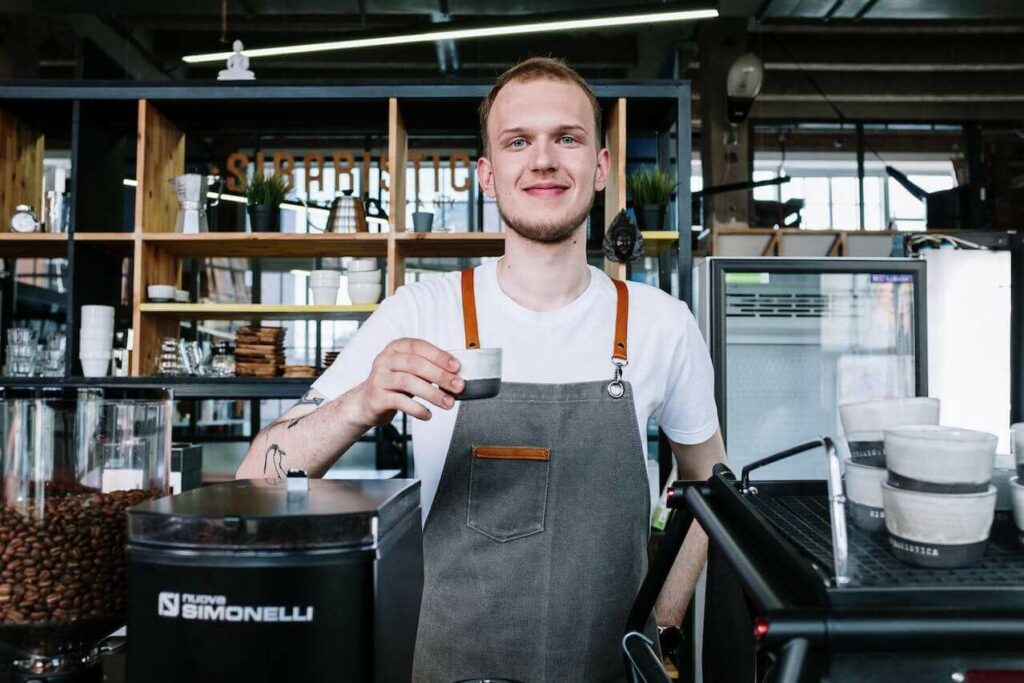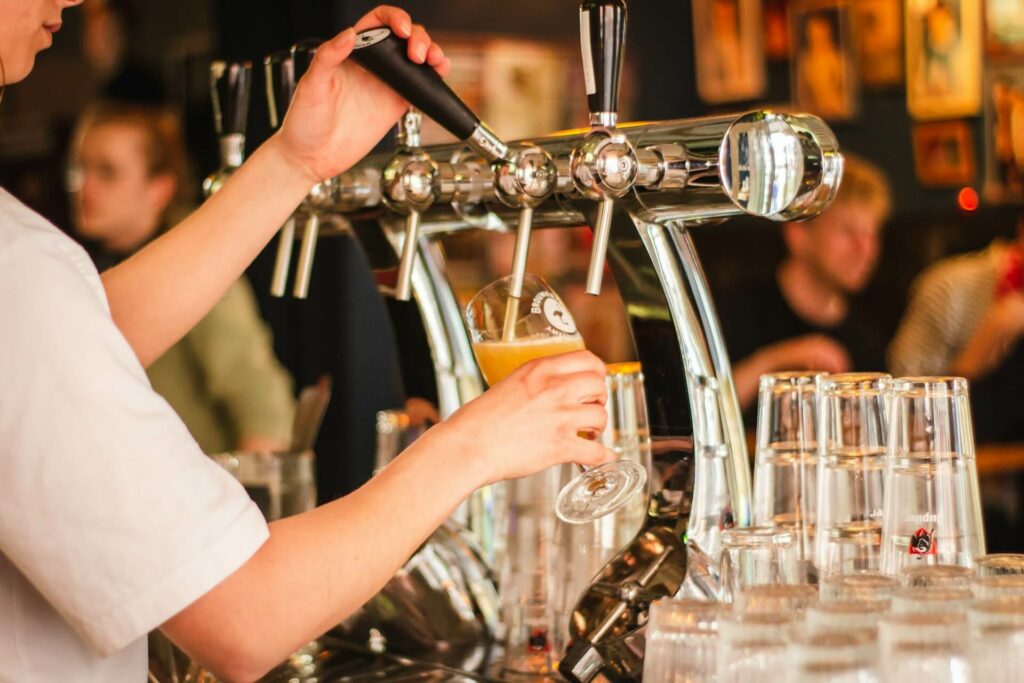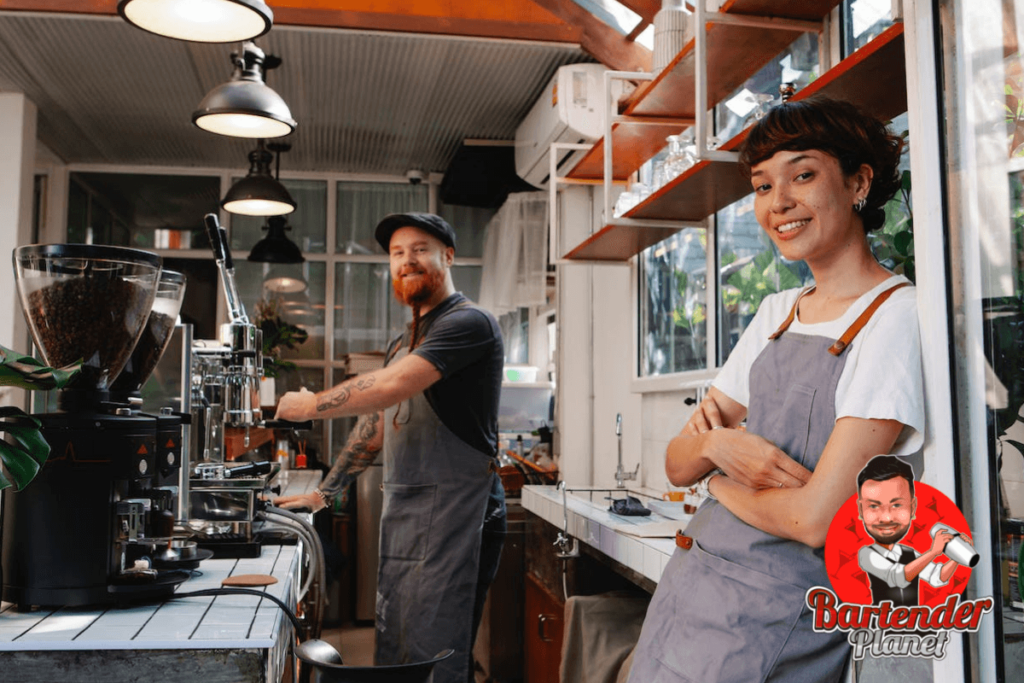Ever find yourself at a cafe, staring at the person behind the counter, and wondering if they’re more skilled in shaking cocktails or crafting the perfect cappuccino?
Welcome to the conundrum of bartender vs barista! In the beverage world, these two roles often blur the lines, so it’s easy to get them confused with one another.
In this post, we’ll look at the subtle yet significant differences between the mixology maestros and the espresso aficionados.
Let’s get into it…
What Is A Bartender?
A bartender is a pivotal figure in the food and beverage industry who serves alcoholic drinks to customers.
Aside from that, they are responsible for providing excellent customer service in various settings like bars, restaurants, and private events.
While a high school diploma is often sufficient, bartenders may undergo a training program to hone their customer service skills, grasp drink recipes, and understand brewing methods, ensuring they are well-versed in the craft of beverage service.
From crafting cocktails to pouring craft beer, a bartender’s skills vary depending on the establishment and its focus.
They serve alcohol responsibly by adhering to the legal drinking age and often handle credit card transactions in the bar area.
Bartenders are not just masters at mixing drinks; they are adept at handling difficult customers, problem-solving, and communicating effectively to create a memorable experience for patrons.
Whether it’s early morning or late at night, these professionals, each with their own unique set of skills, contribute significantly to the dynamic and social nature of the drink and food industry.
In essence, a bartender depends on their versatility to cater to diverse preferences, making them indispensable in the world of alcoholic beverages.
What Is A Barista?
A barista serves coffee-based beverages, making them a key player in the realm of non-alcoholic drinks.
They’re often found in coffee shops, where they specialize in serving drinks like coffee, lattes, cappuccinos, and other similar beverages.
Whether it’s brewing the perfect espresso or creating intricate latte art, baristas are experts in the art of making coffee.
Their expertise extends to different brewing methods, ensuring that the nuances of coffee beans are captured in each cup.

Beyond coffee, they may also serve other non-alcoholic beverages and cold beverages, diversifying their offerings to suit various preferences.
Since baristas typically work at a coffee shop, serving coffee directly to customers, they too need to possess effective communication and interaction skills.
That can help them to understand their preferences and deliver a personalized coffee experience.
It’s also important to note that baristas are found not only in dedicated coffee shops but also in restaurants.
Barista Vs. Bartender – Identifying The Differences
Now that you have a basic understanding of baristas and bartenders, it is time to look at what sets them apart from each other.
Sure, they are both required to serve drinks and communicate effectively with patrons, but that’s where the similarities between them end.
On that note, below are some of the key differences between baristas and bartenders:
1. Skills Required
The skills required for a barista and a bartender, though both rooted in the service industry, reflect the distinct nature of their professions.
For bartenders, an in-depth knowledge of mixology and drink recipes is vital to their success.
They are experts in crafting and serving alcoholic drinks, navigating the world of cocktails, and ensuring responsible service in adherence to legal drinking ages.
Strong customer service skills are crucial for engaging with patrons, handling credit card transactions, and creating a memorable experience.
On the other side of the spectrum, baristas excel in the art of coffee brewing and preparation techniques.
Like bartenders, baristas also need strong customer service and communication skills to ensure they understand and meet the preferences of coffee enthusiasts.
Quick thinking and patience are key as they handle complex coffee orders during peak hours.
While both professions require quick thinking and problem-solving, one major difference lies in the physical demands.
Bartenders need physical strength and endurance to navigate a busy bar environment, while baristas require stamina and dexterity for the intricate and repetitive tasks involved in crafting and serving the perfect cup of coffee.
2. Job Requirements
The job requirements for a barista and a bartender encompass distinct qualifications and certifications, mirroring the specific demands of their respective roles.
For a barista, a strong foundation in coffee brewing and preparation techniques is essential.
While a high school diploma may be sufficient in most cases, many employers prefer candidates with additional training from specialized programs or workshops.
Baristas might also pursue certifications from specialized institutions such as the International Barista & Coffee Academy or the Specialty Coffee Association to enhance their expertise.
On the other hand, a bartender typically requires knowledge of mixology and drink recipes.
While a high school diploma is commonly accepted, aspiring bartenders may benefit from completing a bartending school program, which covers topics like drink preparation, customer service, and legal responsibilities.
Some states may also mandate alcohol server certification, emphasizing responsible service and awareness of legal regulations.
Most states will also require aspiring bartenders to be over 18 years of age.
Employers in the coffee industry generally seek baristas with a passion for coffee, excellent customer service skills, and the ability to work efficiently in a fast-paced environment.
Whereas establishments serving alcoholic beverages, such as bars and restaurants, look for bartenders with an understanding of customer service.
They also tend to prefer candidates with prior experience in the industry.
While both professions may start with a high school diploma, baristas focus on coffee expertise and may pursue specific certifications.
Bartenders lean towards mixology knowledge and may require alcohol server certification, reflecting the demands of their roles in the service industry.
3. Average Salary
In the United States, the salary differences between baristas and bartenders are influenced by various factors, including location, experience, and the type of establishment.
According to the Bureau of Labor Statistics (BLS) data from May 2022, the mean hourly wage for bartenders is $16.58, while the mean annual wage is $34,490.
But, it’s important to note that bartenders often supplement their income through tips, which can significantly impact their overall earnings.
On the other hand, baristas typically earn a base hourly wage with the potential for tips.
According to a recent report published by PayScale, the average hourly rate for a barista in the U.S. is around $12.09.

The variation in salaries is influenced by factors such as the location and the type of coffee establishment.
High-end specialty coffee shops in metropolitan areas may offer higher wages compared to smaller, independent cafes in suburban or rural areas.
As you can see, bartenders have a higher median hourly wage than baristas, which might make it a more lucrative career opportunity.
Also, the tipping culture in bars can contribute substantially to their overall income.
Baristas, although generally earning a lower base wage, may find their earnings supplemented by bonuses and commissions, but to a lesser extent than bartenders.
The earning potential for both professions can vary significantly based on individual circumstances, geographical location, and the nature of the establishments they work in.
4. Work Environment
The work environments for baristas and bartenders differ quite drastically.
Baristas typically find themselves in coffee shops, creating a cozy and often relaxed atmosphere.
The ambiance is usually more daytime-oriented, catering to people seeking a caffeine fix or a quiet place to work.
The setting is social but leans towards a quieter and more focused environment. But the work ambiance may become a bit dull during the latter part of the day.
Bartenders work in a more lively and dynamic setting, such as a bar, a restaurant, or a nightclub.
The atmosphere is often more energetic, especially during evenings and weekends. Loud music, dim lighting, and a lively crowd are common features of a bartender’s work environment.
The social aspect is strong too, with bartenders engaging in conversations, entertaining patrons, and often working in fast-paced conditions.
On the flip side, bartenders are usually required to put in long hours at night, which can be EXHAUSTING. Trust me on that.
They may also have to deal with rude customers more frequently than baristas.
While both professions involve customer interaction, the work environments dictate the tone of those interactions.
Baristas create a more relaxed and daytime-oriented atmosphere, focusing on creating a pleasant and comfortable space for coffee drinkers.
Whereas, bartenders thrive in the lively evening ambiance of bars, where their skills are put to the test in a more socially charged setting.
5. Demographics
Baristas and bartenders often attract slightly different demographic profiles due to the distinct nature of their professions and the environments in which they work.
And while there are obvious differences between the demographics of these two professions, there are some similarities in trends as well.
Baristas commonly span a broad age range, with a notable presence of younger individuals, including students and part-time workers.
According to a recent report, there are more than 474,463 baristas working in the US at present, and the average age of this profession is around 23 years.
Also, over 69% of the baristas are women, which shows that women are more likely to take up this profession than men.

Bartenders, on the other hand, often exhibit a slightly older demographic, with many individuals choosing bartending as a long-term career.
A report published recently has shown that there are over 568,533 bartenders working in the US at present, with the average age being 34 years.
However, the gender demographics trend for bartenders is a bit similar to baristas, with over 60% of bartenders being women.
Benefits And Drawbacks Of Working As A Bartender
Benefits
- Potential for high earnings: Tips can significantly boost income. A LOT.
- Social interaction: Engaging with diverse patrons develops social skills.
- Dynamic environment: Fast-paced and lively work atmosphere.
- Creativity: Opportunities to craft unique cocktails and showcase mixology skills.
Drawbacks
- Late hours: Often involves working evenings and weekends.
- Physically demanding: Requires stamina and mental endurance for long hours.
- Intoxicated customers: Handling difficult situations with patrons who have overindulged. Go figure.
- High stress: Managing multiple orders and maintaining a thriving bar can be stressful.
Benefits And Drawbacks Of Working As A Barista
Benefits
- Daytime hours: Typically involves daytime shifts.
- Skill development: Opportunity to hone coffee brewing and preparation techniques.
- Extra income potential: Some establishments offer bonuses and commissions, supplementing income.
- Relaxed environment: Generally, it is a more chill setting than most bars.
Drawbacks
- Lower overall earnings: Base wages may be lower than some tipped positions.
- Repetitive tasks: Involves routine tasks like grinding coffee and making espresso.
- Limited career progression: Fewer growth opportunities compared to other roles in the food and beverage industry.
Wrapping Up
In the conversation comparing bartenders and baristas, it’s clear that each role has its own distinct set of skills, qualifications, and workplace atmospheres, highlighting the unique nature of both professions.
Bartenders excel in the lively realm of mixology, where they mix and serve alcoholic beverages in energetic environments.
On the other hand, baristas are connoisseurs of coffee, skillfully preparing drinks in settings that often offer a more laid-back atmosphere.
While there are differences in how they earn and the demographics they cater to, both bartenders and baristas are essential to the rich fabric of the food and beverage industry.
In the end, whether one chooses to be a bartender or a barista depends on their individual passion, preferences, and their drive to provide unique and unforgettable experiences to their customers.
I may be slightly biased as I’ve been a bartender for a long time and have seen firsthand how the industry is rapidly growing.
But I encourage you to explore the coffee world if you’re not interested in working in a loud, alcohol-fueled environment.
See you next time.


